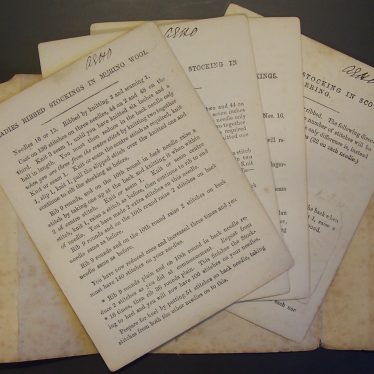If you are looking for a new hobby to take up in this New Year, why not give knitting a try? Here are a couple of patterns to get you started!
Taken from the Townsend family papers, these pattern cards1 are thought to date from the 1860s and include general instructions for the knitting of stockings, as well as individual patterns for a gentleman’s knickerbocker, a ladies ribbed stocking in merino wool and stockings for boys and girls. The lovely thing about them is that you can still see the knitter’s annotations in pencil adjusting for size on the child’s stocking pattern.
The annotations may well have come from Anne Elizabeth Hardcastle Olivier, whose initials appear on each pattern.
The patterns are a compilation titled How to Knit Stockings and are kept in the small burgundy packet which would have been available via mail order at the time. Although they don’t credit a writer, they could have been created by Miss Elizabeth Ryder, a knitting writer from Yorkshire, who produced similar collections around that time.
Historical knits
Fabrics made by using needles to loop and knot yarns have been manufactured for centuries. One of the earliest knitted items is a pair of sandal socks (with a divided toe) from Egypt thought to date from the 3rd to 5th century, currently held by the Victoria and Albert Museum. Unlike weaving, knitting does not need heavy equipment, so was commonly taken up by early nomadic tribes and agricultural populations.
Complex knitted fragments have been discovered throughout Europe and there are medieval paintings which depict the Virgin Mary knitting including Our Lady Knitting by Tommaso da Modena (c1325-1375) and Madonna Knitting, part of the Buxtehude Altar from 1400-10 by Master Bertram of Minden. The earliest knitting pattern discovered dates from 1524.
Knitting as a hobby
After the Industrial Revolution and the advent of framework (machine) knitting, hand knitting declined as an industry but remained popular as a hobby.
If you are still looking for a reason to pick up the needles, here is Mrs Lewis’s advice from her 1884 book Wools and How to Use Them. “Knitting does not require much thought, and is therefore excellent for those women whose minds are occupied with weighty matters which they can think about as well, or even better, while their fingers are employed.”
1 Warwickshire County Record Office reference CR4651/706
Further reading
Mrs E Lewis. Wools and How to Use Them: (Jevons and Mellor, Birmingham 1884)
The Knitting Hub: Victoria and Albert Museum.
Tulasi Zimmer. The History of Knitting in Art: (Crystal Moon Publishing, USA 2013)
This is January’s Document of the Month for the Warwickshire County Record Office. Further articles can be found on their website.










Comments
Add a comment about this page